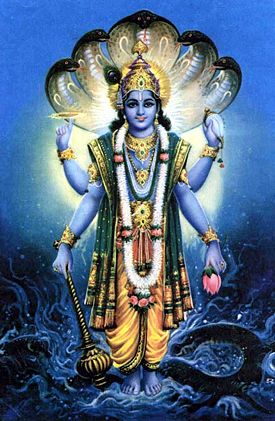Devas and avatars
The Hindu scriptures refer to celestial entities, called Devas (or devī in feminine form; devatā used synonymously for Deva in Hindi), "the shining ones", which may be translated into English as "gods" or "heavenly beings". The devas are an integral part of Hindu culture and are depicted in art, architecture and through icons, and mythological stories about them are related in the scriptures, particularly in the Indian epic poetry and Puranas. They are however often distinguished from Ishvara, a supreme personal God, with many Hindus worshiping Ishvara in a particular form as their devatāor chosen ideal; the choice being based upon their individual preference, and regional and family traditions.
Hindu epics and the Puranas relate several episodes of the descent of God to Earth in corporeal form, in order to restore dharma in society and guide humans to moksha (liberation from the cycle of rebirth). Such an incarnation is called an avatar. The most prominent avatars are of Vishnu, and include Rama (protagonist in Ramayana) and Krishna (a central figure in the epic Mahabharata).
The main devas are (vide 6th anuvaka of Chamakam):
The main Devis (goddesses) are:
- Vaak or Sarasvati
- Uma or Shivaa
- Lakshmi or Shri
Avatar
In Hindu philosophy, an avatar (also spelled as avatara) , most commonly refers to the incarnation (bodily manifestation) of a divine being (deva), or the Supreme Being (God) onto planet Earth. The Sanskrit word avatāra- literally means "descent" (avatarati) and usually implies a deliberate descent into lower realms of existence for special purposes. The term is used primarily in Hinduism, for incarnations of Vishnu whom Vaishnava Hindus worship as the supreme God. Shiva and Ganesha are also described as descending in the form of avatars, with the Ganesha Purana and the Mudgala Purana detailing Ganesha's avatars specifically.
The word has also been used by extension to refer to the incarnations of God or highly influential teachers in other religions, especially by adherents to Dharmic Traditions when explaining figures such as Jesus.
For more knowledge go to
http://en.wikipedia.org/wiki/Vishnu
References
- Bhag-P 1.3.26 "O brahmanas, the incarnations of the Lord are innumerable, like rivulets flowing from inexhaustible sources of water"
- gaudiya.com - theology
- Teachings of Lord Chaitanya - Avatars
- B-Gita 8.17 "And finally in Kali-yuga (the yuga we have now been experiencing over the past 5,000 years) there is an abundance of strife, ignorance, irreligion and vice, true virtue being practically nonexistent, and this yuga lasts 432,000 years. In Kali-yuga vice increases to such a point that at the termination of the yuga the Supreme Lord Himself appears as the Kalki avatara"
